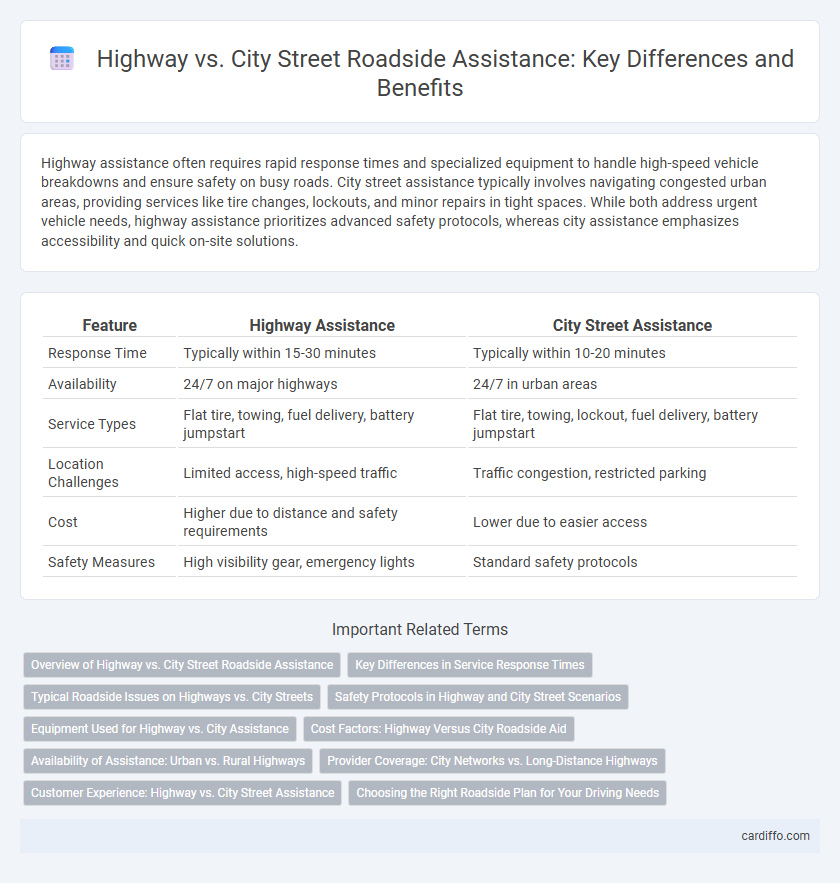Highway assistance often requires rapid response times and specialized equipment to handle high-speed vehicle breakdowns and ensure safety on busy roads. City street assistance typically involves navigating congested urban areas, providing services like tire changes, lockouts, and minor repairs in tight spaces. While both address urgent vehicle needs, highway assistance prioritizes advanced safety protocols, whereas city assistance emphasizes accessibility and quick on-site solutions.
Table of Comparison
| Feature | Highway Assistance | City Street Assistance |
|---|---|---|
| Response Time | Typically within 15-30 minutes | Typically within 10-20 minutes |
| Availability | 24/7 on major highways | 24/7 in urban areas |
| Service Types | Flat tire, towing, fuel delivery, battery jumpstart | Flat tire, towing, lockout, fuel delivery, battery jumpstart |
| Location Challenges | Limited access, high-speed traffic | Traffic congestion, restricted parking |
| Cost | Higher due to distance and safety requirements | Lower due to easier access |
| Safety Measures | High visibility gear, emergency lights | Standard safety protocols |
Overview of Highway vs. City Street Roadside Assistance
Highway roadside assistance typically addresses high-speed vehicle breakdowns requiring rapid response and specialized equipment to ensure safety on fast-moving lanes. City street assistance often involves lower-speed incidents with easier access and quicker arrival times due to denser service coverage and proximity. Both services provide essential support but differ in response strategies, safety protocols, and service availability based on the location's traffic conditions and infrastructure.
Key Differences in Service Response Times
Highway assistance typically offers faster service response times due to dedicated patrols and priority dispatch in high-traffic or emergency zones. City street assistance may experience longer wait times caused by denser traffic, varied road conditions, and complex urban navigation. Efficient route planning and real-time traffic monitoring are critical factors influencing response speed in both environments.
Typical Roadside Issues on Highways vs. City Streets
Highway assistance typically addresses high-speed tire blowouts, fuel shortages in remote areas, and multi-vehicle accidents that require rapid clearance to prevent traffic congestion. City street assistance often involves resolving battery failures, lockouts, and minor collisions amid heavy traffic and narrow lanes. The contrast in roadside issues highlights the need for specialized equipment and rapid response tailored to the environment's unique challenges.
Safety Protocols in Highway and City Street Scenarios
Highway assistance protocols prioritize rapid response and visibility due to higher speeds and increased traffic volume, implementing safety measures such as reflective gear, flares, and emergency lane usage to prevent accidents. City street assistance focuses on pedestrian protection and minimizing traffic disruption by coordinating with local traffic signals and utilizing portable barriers to create safe work zones. Both scenarios require adherence to local regulations and constant situational awareness to ensure the safety of both responders and motorists.
Equipment Used for Highway vs. City Assistance
Highway assistance vehicles are typically equipped with heavy-duty towing apparatus, winches, and high-capacity air compressors to manage large trucks and rapid response needs on fast-moving traffic lanes. In contrast, city street assistance relies on compact tools such as portable jump starters, compact tire inflators, and lightweight towing dollies suited for navigating tight urban spaces and dealing with smaller vehicles. Specialized GPS and communication systems are employed by both to ensure efficient dispatch and precise location tracking within their respective environments.
Cost Factors: Highway Versus City Roadside Aid
Highway roadside assistance typically incurs higher costs due to extended travel distances, increased risk factors, and the necessity for specialized equipment to handle high-speed road conditions. City street assistance generally offers lower fees as service providers benefit from shorter response times, easier access, and more frequent operations within densely populated areas. Understanding these cost factors helps consumers anticipate expenses and choose the most appropriate roadside aid for their location.
Availability of Assistance: Urban vs. Rural Highways
Highway assistance availability varies significantly between urban and rural settings, with urban highways often benefitting from rapid response times due to higher traffic density and more frequent service stations. Rural highways tend to have limited roadside assistance options, causing longer wait times and reduced access to immediate help. Emergency services and tow companies are generally concentrated near cities, making urban highway assistance more accessible and reliable compared to isolated rural areas.
Provider Coverage: City Networks vs. Long-Distance Highways
Highway assistance providers typically offer extensive coverage across long-distance routes, ensuring help is available in remote or less populated areas, while city street assistance focuses on dense urban networks with a higher frequency of service requests. Providers with city network specialization often have faster response times due to proximity and a well-established presence in metropolitan areas. Long-distance highway assistance requires robust fleet management and partnerships along major interstate corridors to maintain reliable service coverage.
Customer Experience: Highway vs. City Street Assistance
Highway assistance often ensures faster response times and more specialized services due to predictable routes and emergency protocols, enhancing overall customer satisfaction during critical situations. In contrast, city street assistance navigates complex traffic patterns and varied urban obstacles, which can lengthen wait times but offers more personalized support tailored to dense, high-activity environments. Customers value highway assistance for efficiency and reliability, while city street assistance is appreciated for adaptability and localized expertise in urban conditions.
Choosing the Right Roadside Plan for Your Driving Needs
Highway assistance plans often cover extended towing distances and rapid emergency response, essential for long-distance travel and high-speed incidents. City street assistance tends to focus on quicker, localized services such as jump-starts, tire changes, and fuel delivery within urban environments. Selecting the right roadside plan depends on your typical driving routes and frequency of highway versus urban driving to ensure tailored coverage and cost-effectiveness.
Highway assistance vs city street assistance Infographic

 cardiffo.com
cardiffo.com